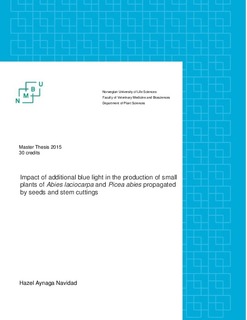| dc.contributor.author | Navidad, Hazel | |
| dc.date.accessioned | 2016-04-01T12:07:21Z | |
| dc.date.available | 2016-04-01T12:07:21Z | |
| dc.date.issued | 2016-04-01 | |
| dc.identifier.uri | http://hdl.handle.net/11250/2383572 | |
| dc.description.abstract | The goal of this study was to examine how additional blue light affected growth and development of Picea abies and Abies laciocarpa seedlings and stem cuttings. The experiment was conducted at the Center for climate regulated plant research, Norwegian University of Life Sciences, (Ås Norway) in closed growth chambers with high pressure sodium (HPS) as the main light source. The seedlings germinated in a greenhouse compartment (3 weeks) and moved to closed growth chambers with different light treatment. The light was provide continuously with no dark period and the temperature was set to 22° C, relative humidity 85% CO2 level was ambient (400ppm). The light quality was by High Pressure Sodium (HPS) lamps (300μmol m-2 s-1) or a combination with High Pressure Sodium + blue light emitting diodes (HPS+BL: 300 μmol m-2 s-1 + 75μmol m-2 s-1). Thus, the photosynthetic active radiation was 300μmol m-2 s-1 in both treatments and the red to far-red ratio was 3.5.
After 2 months of growth, morphology, water loss and chlorophyll content of seedlings as well as dry matter accumulation in stems, needles, and roots were measured. The results showed that the responses of P. abies seedlings to light quality were more stronger than in A. laciocarpa. In P. Abies, thicker stem diameter, pronounced branches, higher significant differences in fresh weight and dry weight of roots and needles was found in produced with additional blue light compared to HPS alone. In addition, P. abies has a significant higher water loss when exposed to blue light compared to HPS. In chlorophyll content measurement the only significant difference was found in A. laciocarpa exposed to HPS+BL. In this treatment 50% higher content of chlorophyll b was found compared to HPS. More terminal buds were also observed in additional blue light in A. laciocarpa compared to HPS. However, P. abies did not produce any terminal buds during the experimental period. On the other hand, A. laciocarpa showed a different growth response to blue light than P. abies and a higher dry weight were found in stems and needles when they were exposed to HPS alone compared to additional blue light. The result from this thesis shows that the different species behave differently in response to additional blue light. Additional blue light seems to have a positive effect on the growth of P. abies but not for A. laciocarpa.
However, the potential after-effects of growth under different light quality and different environmental conditions after planting to forest site are still unknown.
Furthermore, both species can be propagated by stem cuttings but no significant effect of light quality on rooting was observed in this experiment due to huge variation between the cuttings. | nb_NO |
| dc.description.sponsorship | LIght quality responses in forest trees | nb_NO |
| dc.language.iso | eng | nb_NO |
| dc.publisher | Norwegian University of Life Sciences, Ås | |
| dc.rights | Navngivelse 3.0 Norge | * |
| dc.rights.uri | http://creativecommons.org/licenses/by/3.0/no/ | * |
| dc.title | Impact of additional blue light in the production of small plants of Abies laciocarpa and Picea abies propagated by seeds and seedlings | nb_NO |
| dc.type | Master thesis | nb_NO |
| dc.subject.nsi | VDP::Agriculture and fishery disciplines: 900::Agriculture disciplines: 910::Plant breeding, horticulture, plant protection, plant pathology: 911 | nb_NO |
| dc.source.pagenumber | 65 | nb_NO |
| dc.relation.project | Light quality responses in forest trees | nb_NO |
| dc.description.localcode | M-PV | nb_NO |

